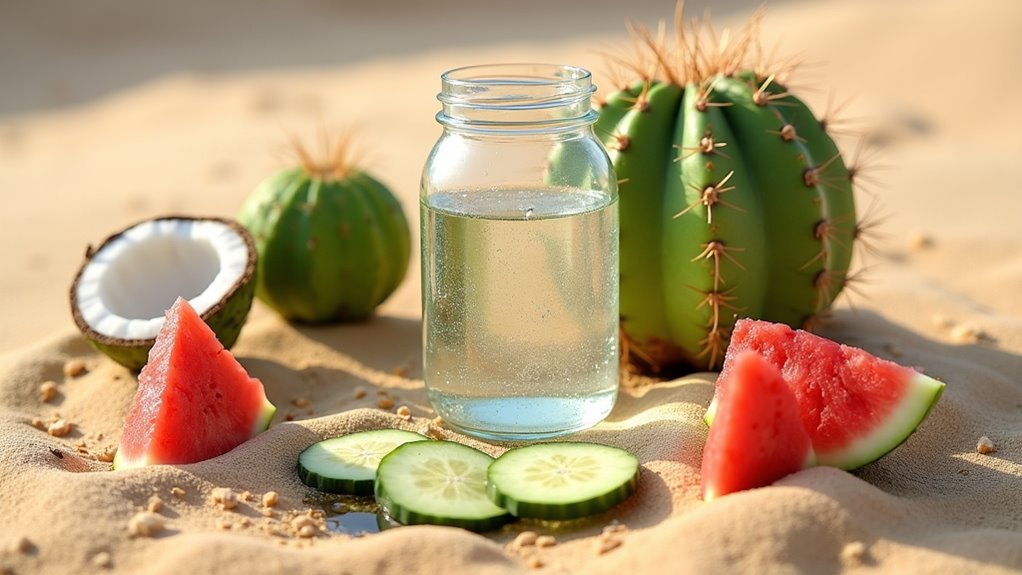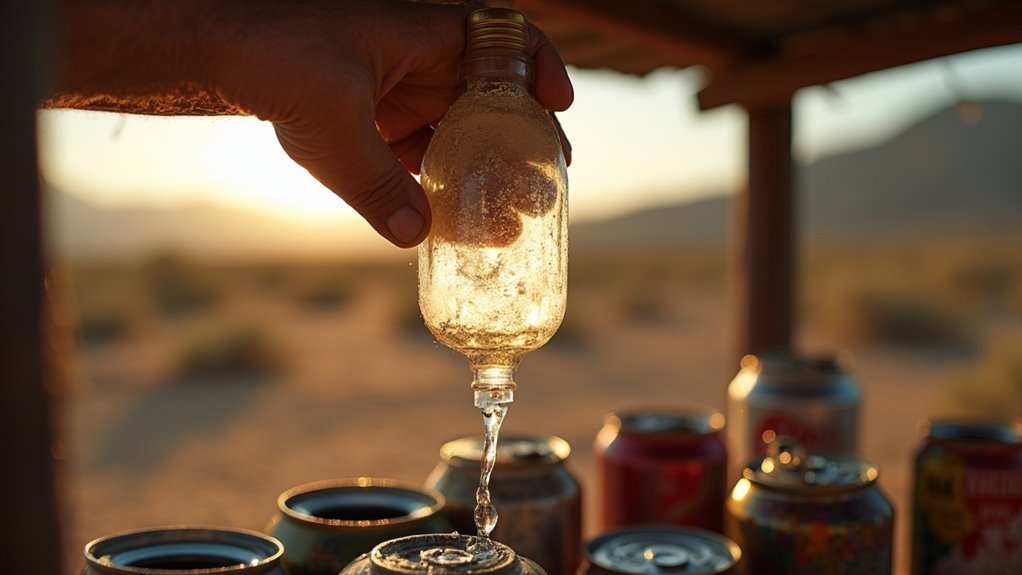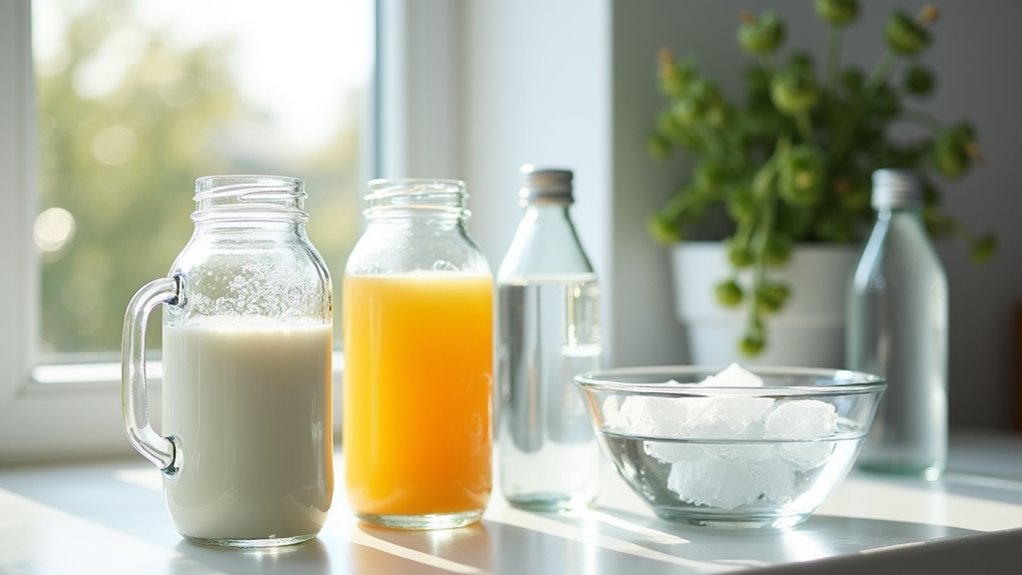Physical Address
304 North Cardinal St.
Dorchester Center, MA 02124
Physical Address
304 North Cardinal St.
Dorchester Center, MA 02124

Thirst can be conquered through six surprising water sources hiding around you when traditional supplies run dry.
You probably don’t realize that your body can extract hydration from dozens of unexpected sources when your water supply disappears. While panic might be your first instinct, there’s actually a surprising number of ways to quench your thirst using items you’d normally overlook. From the moisture hiding in common plants to clever collection methods you can build in minutes, these resourceful techniques could mean the difference between dangerous dehydration and staying properly hydrated until help arrives.

When you’re stuck without water, your kitchen’s produce drawer becomes your best friend. Fresh fruits pack serious hydration power—watermelon contains 92% water, while oranges and grapes deliver both fluids and natural sugars to combat thirst effectively.
Don’t overlook vegetables either. Cucumbers are 96% water and provide instant relief. Celery stalks crunch with moisture, and lettuce leaves contain surprising amounts of fluid. You can eat these raw or blend them into quick smoothies.
Tomatoes work double duty, offering hydration plus electrolytes. Even carrots contribute meaningful moisture content. Keep citrus fruits handy—they’ll quench thirst while providing vitamin C. While foraging for wild fruits during outdoor adventures, be cautious of areas where tick bites are common, as these parasites often lurk in vegetation.
While produce provides temporary relief, you’ll need to scout your surroundings for actual water sources if the situation persists. Look for streams, springs, or even morning dew collecting on surfaces. Rain gutters and downspouts can catch fresh precipitation, while tree hollows sometimes hold clean rainwater. Check for condensation on pipes or air conditioning units – it’s distilled water that’s safe to drink.
If you’re near buildings, search for water heater tanks or toilet reservoir tanks (not the bowl). Rocky areas often have natural springs seeping through cracks. Even puddles can work in emergencies, though you’ll want to filter them through cloth first. Remember, moving water is generally safer than stagnant pools.
Stay observant and think creatively about where water naturally collects in your environment. For serious outdoor enthusiasts, mastering these water-finding techniques becomes part of essential camping tricks that can transform a potentially dangerous situation into a manageable adventure.

Once you’ve identified potential water sources, you’ll need to maximize collection by building simple systems from materials around you. Don’t overlook everyday items that can become lifesaving water collectors.
Here are four effective makeshift collection methods:
You’ll be surprised how efficiently these simple systems work when properly positioned. These techniques are especially valuable during caravan camping adventures where access to traditional water sources may be limited.
Plants can be your underground water suppliers when traditional sources aren’t available. You’ll find moisture in unexpected places if you know where to look. Cut into thick vines and let the water drip into your mouth – bamboo works particularly well.
When conventional water sources fail, nature’s hidden reservoirs in thick vines and bamboo can provide life-saving hydration in survival situations.
Morning dew on grass and leaves provides another option; use cloth to absorb it, then wring the water into a container.
Tree sap from birch and maple trees offers hydration, though it’s best in spring. You can also create plant stills by tying plastic bags around leafy branches – condensation will collect as the sun heats the leaves.
Cacti and succulent plants store water in their flesh, but avoid milky or colored saps as they’re often toxic.
If you’re in mountainous terrain, you can also melt snow or ice from glacier formations to obtain fresh water for drinking.

Your kitchen and bathroom contain several safe liquid alternatives that can help you stay hydrated during water shortages. Don’t overlook these common household liquids when you’re desperate for hydration.
Here are four household liquids you can safely consume:
Check expiration dates before consuming anything. Avoid alcohol-based products, cleaning supplies, and anything containing chemicals.
These emergency alternatives won’t replace water long-term, but they’ll keep you hydrated until you find a proper water source.
When temperatures drop below freezing, ice and snow become valuable water sources that many people overlook during emergencies. You’ll need to melt these frozen resources before consuming them, as eating ice or snow directly can lower your core body temperature dangerously.
Collect clean snow from undisturbed areas, avoiding yellow, dirty, or roadside snow that’s contaminated. Fresh powder works best since it’s typically cleaner than older, compacted snow.
You can melt it using body heat by placing small amounts inside your clothing, though this method’s slow and can make you colder.
If you’ve got access to fire or heat sources, melt larger quantities in containers. Remember that snow yields surprisingly little water – you’ll need about ten cups of snow to produce one cup of drinking water.
Just like choosing the right camping tent requires careful consideration of your specific needs, selecting the best snow and ice sources demands attention to cleanliness and accessibility.
You’re now armed with a survival toolkit that’ll turn you into a hydration detective when water’s nowhere to be found. Don’t let thirst become your worst enemy—nature’s got your back with fruits, plants, and creative collection methods. Remember, you’re tougher than you think, and these techniques can literally be lifesavers. Stay resourceful, think outside the box, and you’ll weather any dry spell that comes your way.